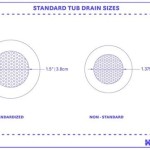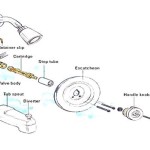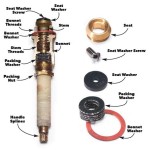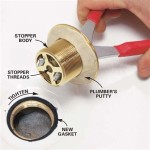How To Get Yellow Bleach Stains Out Of Bathtub Drain
The appearance of yellow stains in a bathtub drain is a common household issue, often resulting from specific chemical reactions. Bleach, while a potent cleaning agent, can interact negatively with certain materials and substances commonly found in drains, leading to discoloration. Understanding why these stains occur, and the appropriate methods for their removal, is essential for maintaining the hygiene and aesthetics of a bathroom.
The primary cause of yellow stains following bleach usage is the reaction between the bleach (sodium hypochlorite) and existing minerals, rust, or organic matter present in the drain. Bleach acts as an oxidizer. This oxidation process alters the chemical composition of these substances, frequently resulting in the formation of yellow or brownish-yellow compounds. Iron, a common component in plumbing systems, is particularly susceptible to this reaction. Bleach can oxidize iron, transforming it into iron oxide hydrates, commonly known as rust. This rust then leaches out and stains the surrounding areas, including the drain.
Furthermore, the chemical compounds within various shampoos, conditioners, soaps, and body washes can react with bleach, generating byproducts that contribute to the discoloration. Residue from these products accumulates in the drain over time, creating a breeding ground for these reactions when bleach is introduced. The specific chemical composition of the water supply also plays a role. Hard water, which is high in mineral content like calcium and magnesium, can exacerbate the problem. These minerals react with bleach and drain residue, increasing the likelihood of stain formation.
Preventive measures are crucial for minimizing the occurrence of yellow bleach stains. Regular cleaning with alternative, non-bleach-based drain cleaners designed for routine maintenance can significantly reduce the buildup of stain-causing materials. Flushing the drain thoroughly with water after using bleach-containing products can help remove residual bleach and prevent its prolonged contact with the drain’s interior. Avoiding excessive bleach use and opting for diluted solutions can further mitigate the risk of staining.
Addressing yellow stains requires a multi-pronged approach. It is necessary to consider the material of the drain itself, the severity of the stain, and the potential environmental impact of the cleaning solutions. The following sections provide detailed strategies for removing these stains, ranging from gentle home remedies to stronger chemical solutions.
Initial Assessment and Preparation
Before attempting any stain removal method, a thorough assessment of the drain's material is essential. Most bathtub drains are made of chrome, stainless steel, or plastic. The choice of cleaning agent should be compatible with the drain material to prevent damage or further discoloration. A mild approach is always recommended as a starting point. Inspect the staining. Note the intensity and area covered, as this will dictate the strength and duration of treatment needed. Stronger, harsher methods will be needed for darker, more stubborn stains, than lighter less impacted staining.
Preparation involves wearing appropriate protective gear, including gloves and eye protection. Adequate ventilation is crucial, especially when using chemical cleaners. Ensure the bathroom is well-ventilated by opening windows or turning on the exhaust fan. Remove any loose debris or visible blockages from the drain. This will allow the cleaning solution to reach the stain more effectively. Pouring a cup of boiling water down the drain can help loosen some surface buildup. This is a pre-treatment to enhance the effectiveness of the subsequent cleaning steps.
Gentle Cleaning Methods
For mild yellow stains, a combination of baking soda and vinegar can be effective. Baking soda is a mild alkali that can help dissolve organic matter and loosen stains, while vinegar is a mild acid that can help remove mineral deposits and rust. Pour about ½ cup of baking soda down the drain, followed by 1 cup of white vinegar. The mixture will fizz, which is a normal reaction. Allow the mixture to sit in the drain for at least 30 minutes, or preferably overnight, for optimal results. Flush the drain with hot water to remove the baking soda and vinegar residue. Repeat the process if necessary.
Another gentle option is using a paste of baking soda and water. Mix baking soda with enough water to form a thick paste. Apply the paste to the stained area and let it sit for about 30 minutes. Scrub the area gently with a soft brush or sponge and rinse thoroughly with water. For chrome or stainless steel drains, using a soft cloth instead of a brush is recommended to avoid scratching the surface.
Lemon juice is also a natural cleaning agent that can help remove mild stains and deodorize the drain. The citric acid in lemon juice acts as a mild bleaching agent. Pour about ½ cup of lemon juice down the drain and let it sit for about 30 minutes before flushing with hot water. The combination of lemon juice and sunlight can also amplify it's stain removing power, so leaving your curtains/window open can help too. The acids in the juice act as a mild bleaching agent.
Stronger Cleaning Methods
For more stubborn yellow stains, stronger cleaning agents may be necessary. However, caution should be exercised when using these methods, as they can be corrosive or harmful to the environment. Always follow the manufacturer's instructions and wear appropriate protective gear. Prior to attempting any of these methods, it is still recommended to try the gentle cleaning methods first.
Commercial drain cleaners containing sodium hydroxide (lye) or sulfuric acid are powerful agents that can dissolve organic matter and remove stubborn stains. These cleaners are typically available in liquid or granular form. When using these cleaners, carefully follow the instructions on the label and pour the recommended amount down the drain. Allow the cleaner to sit for the recommended time, which can range from 15 minutes to overnight, depending on the product. Flush the drain thoroughly with cold water. Hot water can cause dangerous chemical reactions and may damage the pipes.
Hydrochloric acid (muriatic acid) is a highly corrosive acid that should only be used as a last resort and with extreme caution. It is highly effective at removing mineral deposits and rust but can also damage certain materials. The need for proper ventilation is paramount when using hydrochloric acid. Wear acid-resistant gloves, eye protection, and a respirator. Pour a small amount of diluted hydrochloric acid down the drain, following the manufacturer's instructions. Allow it to sit for a few minutes, and then flush thoroughly with cold water. Never mix hydrochloric acid with other cleaning agents, especially bleach, as this can create toxic chlorine gas.
Another option is to use a rust remover specifically formulated for household use. These products typically contain oxalic acid or phosphoric acid, which can dissolve rust and mineral deposits. Apply the rust remover to the stained area according to the manufacturer's instructions. Let it sit for the recommended time, and then scrub the area gently with a brush or sponge. Rinse thoroughly with water.
Preventive Measures and Maintenance
Prevention is key to avoiding the recurrence of yellow bleach stains in bathtub drains. Regular maintenance and the implementation of preventive measures can significantly reduce the likelihood of stain formation.
Flushing the drain thoroughly with water after each use of bleach-containing products is essential. This removes residual bleach and prevents it from reacting with drain residue. Consider using a drain strainer or screen to catch hair, soap scum, and other debris. This prevents these materials from accumulating in the drain and reacting with bleach. Clean the drain strainer regularly to remove any trapped debris.
Regularly cleaning the drain with a non-bleach-based drain cleaner can help prevent the buildup of stain-causing materials. Choose a drain cleaner that is appropriate for the drain material and follow the manufacturer's instructions. Baking soda and vinegar can also be used as a preventative measure. Pour ½ cup of baking soda down the drain, followed by 1 cup of vinegar. Allow the mixture to sit overnight, and then flush with hot water. Avoid using excessive amounts of bleach when cleaning the bathroom. Diluting bleach solutions and using alternative cleaning agents can reduce the risk of staining. Consider using enzyme-based cleaners, which are designed to break down organic matter without the use of harsh chemicals.
If the water supply is hard, consider installing a water softener to reduce the mineral content of the water. This can help prevent mineral deposits from accumulating in the drain. Periodically inspecting the drain for signs of rust or corrosion can help identify potential problems early. Addressing these issues promptly can prevent more severe staining from occurring. If the drain is severely corroded or damaged, consider replacing it with a new drain made of a more durable material. Stainless steel or plastic drains are less likely to rust than chrome drains. Maintaining the proper pH balance of the water can also help prevent staining. The ideal pH range for water is between 6.5 and 8.5. Using pH testing kits to monitor the water's pH regularly is recommended.
By understanding the causes of yellow bleach stains and implementing appropriate cleaning and preventive measures, it is possible to maintain a clean and stain-free bathtub drain. Regular maintenance and careful attention to the drain's condition can ensure the longevity and aesthetics of the bathroom.

5 Easy Ways To Unclog Bathtub Drain

How To Turn Your Bleach Stained Red Bathtub White Again 4 Steps With Pictures Instructables

Learn How To Remove Bathtub Stains Rooterman

How To Turn Your Bleach Stained Red Bathtub White Again 4 Steps With Pictures Instructables

Clean With Me Removing Rust Stains From A Bathtub And Marble Best Cleaning Ever

How Do I Get My Fiberglass Tub White Again Hometalk

Clorox Stained Bathtub Can Rust Be Removed Faqs Q A Forum

Yellow Hard Water Stains On Tub Hometalk

How To Remove Stains From Bathtub Save Time Money

How To Clean Bathtub Stains Diy Family Handyman
Related Posts








